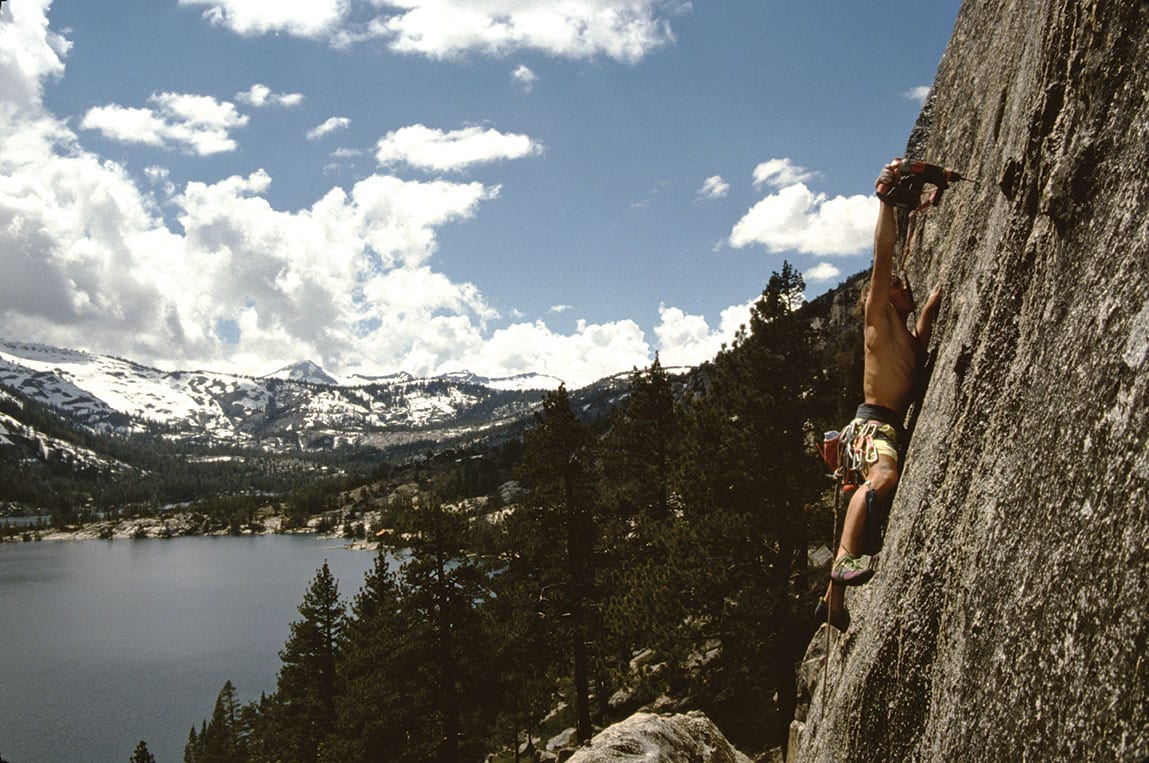
28 Apr Rock Legends
While Yosemite reigns supreme in the annals of rock climbing, the Tahoe area boasts a rich history of its own
With Yosemite as its epicenter, the Sierra Nevada is unquestionably the mecca of rock climbing.
Some argue the sport was born in the Sierra when John Muir performed an on-sight free solo of Cathedral Peak in Tuolumne Meadows in 1869. Muir’s climb, without the benefit of advanced planning or ropes, typifies the adventure, self-reliance, courage and hunger for glory inherent in the sport.
The Lake Tahoe area’s role in the founding and development of modern rock climbing has traditionally been cast as a bit player—a practice facility for climbers looking to refine the skills needed for the daunting big-wall climbs in Yosemite and the High Sierra.
This traditional and dismissive view of the cliffs stretching from Calaveras Dome to Donner Summit has come under recent reconsideration, however, with more and more asserting the area is replete with an array of compelling climbs that factored heavily into the sport’s advancement.
“If you come out to California to go climbing, you are definitely going to stop in Tahoe,” says Gary Allan, a Truckee resident, longtime climber and climbing historian.
In fact, ask any Tahoe climber and they will agree, perhaps with a hint of annoyance—there is no shortage of climbers testing their mettle on the various routes in the greater Tahoe area.
“The great thing is that it’s accessible,” says Mike Carville, a climber and author of several guidebooks about climbing in and around the Lake Tahoe Basin. “It’s not as intimidating as a place like Yosemite and there is a high concentration of high-quality climbs.”
A Leap Forward
Lake Tahoe’s climbing history begins at Lover’s Leap, a well-known granitic band off U.S. Highway 50 near Echo Summit.
Steve Roper, one of the pioneers of modern rock climbing and author of Fifty Classic Climbs of North America—referred to by most in the climbing community as “The Book”—says he first heard of Lover’s Leap from a Sierra Club Bulletin in 1960, when he was still a teenager.
Roper organized a Memorial Day Weekend trip the same year and promptly began exploring the “medium-route paradise.”
Consisting of rough rock, Lover’s Leap’s distinctive feature—horizontal dikes that run across a cliff band consisting of harder granite, which remains as the rest of the cliff erodes—make it one of the most unique climbing experiences in the world.
“I fell in love with the place,” Roper says. “No slippery jam cracks, for one thing. No overhangs. Just that marvelous rough granite.”
Another attractive feature of the Leap in the early ’60s was, unlike Yosemite, nobody was there.
“At the time, and for the rest of the 1960s, [Lovers Leap] had no people, no belay shouts, no climbers above you dropping stuff on your head,” Roper says.
Roper may have had an instrumental hand in changing that, as he wrote the first guide of the Leap in the 1967 edition of Ascent, the publication of the Sierra Mountaineering Club.
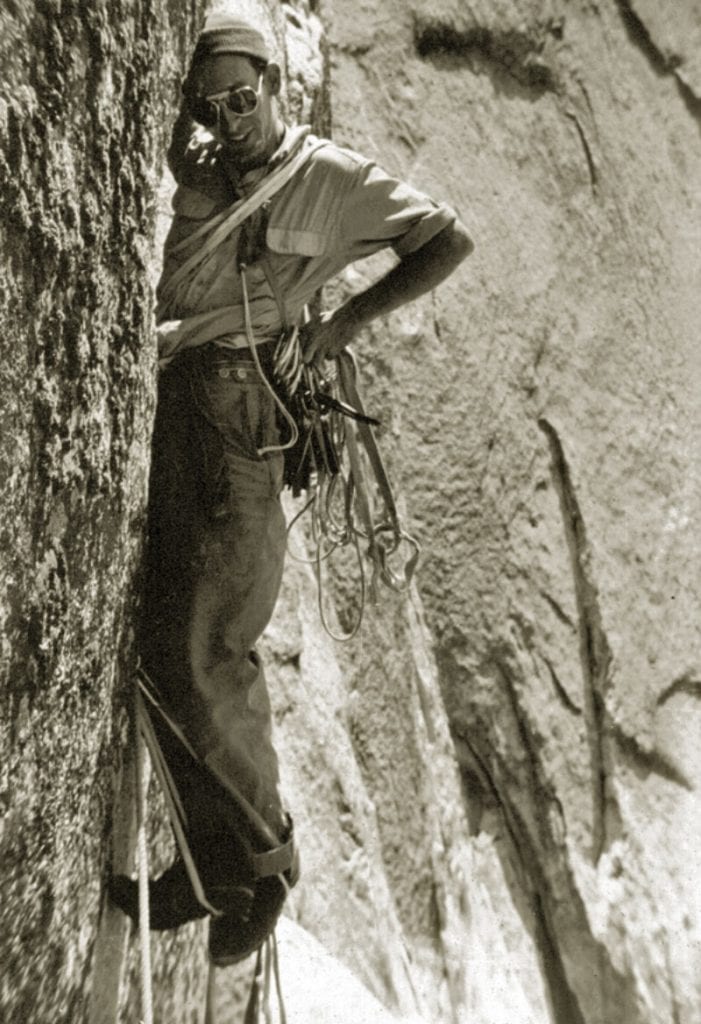
Royal Robbins gained widespread fame for his first ascent of Half Dome’s Regular Northwest Face in 1957, shown here,
photo by Mike Sherrick
But it was not only the guide that led to the popularity explosion. It was the presence of Royal Robbins, one of the legendary figures of rock climbing who passed away this year at age 82. Robbins, famous for his first ascent of Half Dome’s Regular Northwest Face in 1957, ushered in the era of destination rock climbing in the Tahoe area when he opened his Rockcraft Climbing School at Lover’s Leap in the late ’60s.
It didn’t take long for Lover’s Leap to achieve “full-on stature,” according to climber, author, playwright and historian Tom Higgins. “Royal had made his mark,” he says.
Higgins himself made his mark at Lover’s Leap by bagging the first free ascent of The Line—a three-pitch climb that ascends 400 feet up the East Wall. The classic climb calls out to be attempted, as the crack is visible from the road. While the line had been climbed earlier in the decade, Higgins captured the first free ascent in 1968, meaning he didn’t use aid gear.
“At 5.9, it was not at the top standard of the day but a nice line to get, of course,” Higgins says.
Higgins is opting for modesty here. Climbing routes are graded on a scale, typically 5.5 to 5.15, with 5.5 to 5.8 considered beginner, 5.9 to 5.11 considered intermediate and 5.12 to 5.15 considered advanced (generally speaking).
While 5.9 is considered fairly pedestrian by today’s standards, rock climbers in the 1960s were climbing cliffs in hiking boots, a far bridge from today’s sticky rubber shoes designed to fit in cracks, and gain purchase on the thinnest of edges and crystals that protrude from the rock.
“It’s mind-blowing that those guys were making those climbs in [crappy] hiking boots where it’s easy just to grease off something,” says Carville. “It makes 5.9 a hard climb.”
While Robbins may have bagged more lines at Lover’s Leap than is commonly known, all while climbing in hiking boots and using rudimentary pitons, one route unquestionably belongs to him—Fantasia.
Fantasia is a steep 5.9 climb, which climbers describe as more bold than difficult, and is characteristic of Robbins’ rare combination of imagination and audacity.
“I have always been too scared even to follow it,” Roper says. “My bolder friends love it, and it certainly is a classic.”
Renowned for his valor, Robbins also cultivated a stout code of ethics, talked extensively about the spirituality of rock climbing and disdained climbers who hammered bolts into the rock or left pitons in the cracks without cleaning them.
“Royal is too complex a fellow to talk about,” Roper says. “A bit arrogant, definitely bold, a prophet—a stern fellow. With wine in him he relaxed and was a funny fellow.”
The Harding Influence at Sugarloaf
During the advent of rock climbing, Robbins had not only a rival, but an antithesis in Warren Harding.
Born in Downieville, California, Harding said he took to climbing because he “could only do what took brute stupidity”—a far cry from Robbins’ hallowed disquisitions on the discipline.
In 1958, Harding became the first person to ascend El Capitan in Yosemite, although his use of bolts incensed Robbins and still elicits controversy in certain sectors of the climbing community. Harding was unquestionably one of the bravest and most influential climbers of the sport’s nascent period in the Sierra.
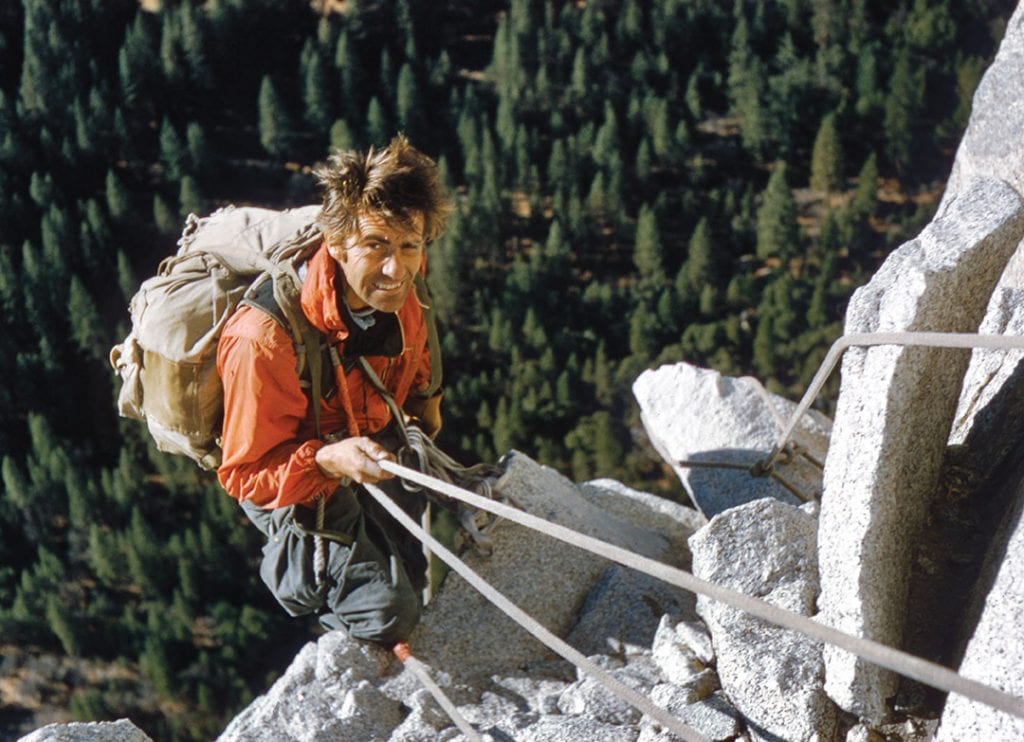 Warren Harding on Yosemite’s El Capitan in 1957, photo by Allen Steck, courtesy T. Adler Books
Warren Harding on Yosemite’s El Capitan in 1957, photo by Allen Steck, courtesy T. Adler Books
While Robbins made his Tahoe mark at Lover’s Leap, Harding made his at Sugarloaf, a comparatively small but distinctive crag just outside of Kyburz, about 9 miles west of the Leap off Highway 50.
Harding’s Chimney, a three-pitch 5.7, scares off climbers even today despite its relatively easy grade. It plays harder than the grade because the first section through the chimney is tricky climbing and is not well protected, meaning lead climbers have to climb as high as 50 feet before placing a piece of protection that will save them in a fall.
Simply put, the climb requires courage and competency, and in a way embodies Harding’s style as a climber and personage.
Harding, who had a crass sense of humor, mocked Robbins and his acolytes for being sanctimonious, and by all accounts drank copious amounts of cheap rotgut red wine.
“Harding was indeed a party animal, but he did have a ‘beverage problem’ and with too much of the red wine in him he could be pretty cruel,” Roper says. “Otherwise, when sober, he climbed well and flirted and drove fancy cars.”
Sugarloaf is lesser known than the Leap, but the granite spire is a favorite winter crag for locals because of its lower elevation and smooth granite akin to that of Yosemite and the High Sierra.
There are plenty of difficult climbs there, with Grand Illusion (a 5.13) being the bellwether. When Tony Yaniro free-climbed it for the first time in 1979, it was widely considered the hardest route in the world.
Donner Summit Explosion
In the early 1970s, when Max Jones first beheld Snowshed Wall off Old Highway 40 on Donner Summit, there was only one developed route on the cliff.
During that time, the focus in climbing was shifting from the big-wall adventure ascents pioneered and perfected by Robbins and Harding and toward free climbing, which demanded more strength, balance and overall athleticism.
Donner Summit was a perfect place to hone those skills.
“It’s an amazing cliff and you only have to walk for about 30 seconds to work on it,” says Jones, who, with his friends Allan, Mark Hudon and others, put up more than a dozen first ascents at the escarpment still renowned for its steep and difficult routes.
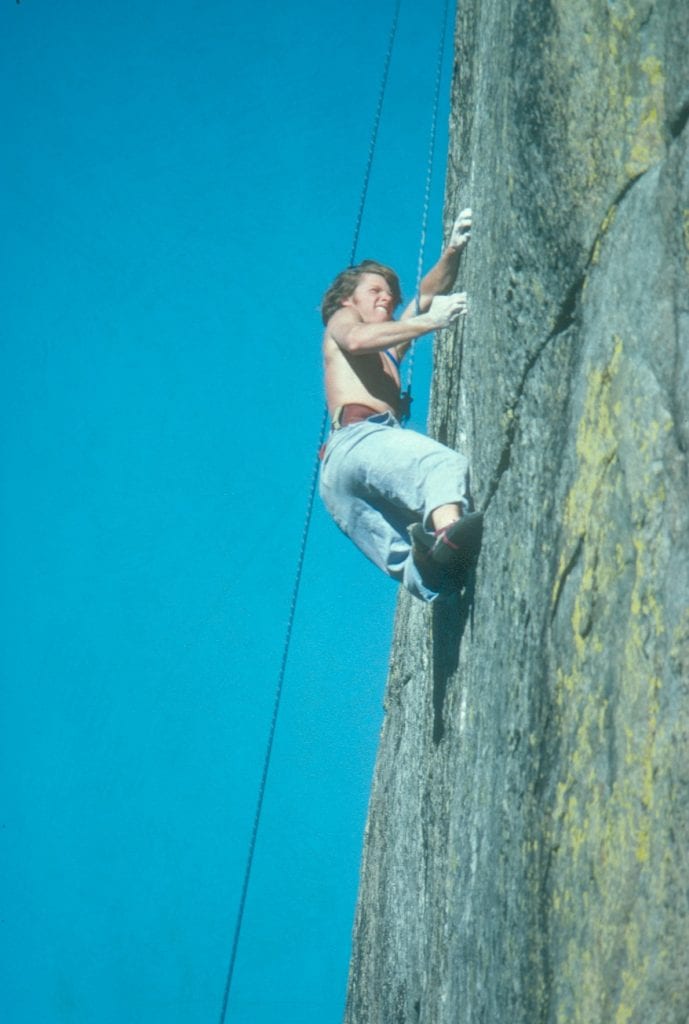
Max Jones climbs Panic in Detroit, a 5.12c, on Donner Summit in 1980, photo courtesy Max Jones collection
“Donner Summit is such a gem,” says Allan. “It just has a lot of good routes and it caters to a lot of different ability levels.”
The climbers represented part of the first wave of climbing development at Donner Summit.
“As the free-climbing craze took hold in the late ’60s and early ’70s, the focus of Tahoe climbing shifted to Donner because of the more technical stuff,” says Carville.
Part of the evolution was due to an emphasis on the more gymnastic movements required by harder climbing on steeper routes with thinner cracks and vanishing holds—and part of it was technological advances in shoes and protective gear.
Another part is that Donner Summit is a climber’s paradise, with a bevy of truly steep lines on rough, featured granite that doesn’t yield or crumble.
Today, Donner Summit consists of several distinct climbing areas—the Black Wall, the South Star Wall, the Green Phantom and Grouse Slabs, to name a few.
But in the mid ’70s, Snowshed was the fulcrum of climbing on the summit.
Jones and Hudon each earned first ascents on Monkey Paws and Panic in Detroit, respectively—two advanced 5.12 climbs with difficult moves, monster cruxes and scant protection.
“We were competing, but it was all friendly,” says Jones.

Mark Hudon climbs Goldilocks, a 5.11a, on Donner Summit, photo courtesy Max Jones collection
The development of those routes increased the profile and popularity of one-pitch climbs that demanded guts and athletic ability. These routes remain popular and are oft repeated, but in the mid ’70s, climbing at that difficulty represented the vanguard of the sport.
“Nobody was climbing 5.12 back then,” Hudon says.
While Jones and Hudon both say it’s nice to open guidebooks and see their names next to first ascents at Donner Summit, they weren’t preoccupied with it at the time.
“Max and I didn’t care,” Hudon says. “We were just going rock climbing, out there to have fun.”
Meanwhile, other legends were busy making their mark on Donner Summit as well.
Jim Bridwell of the Stonemasters, a crew of climbers who are credited for sparking the free-climbing craze and pushing the sport forward, has a fair share of first ascents on the summit—as do Kim Schmitz, Eric Beck and Rick Sylvester. Known for their exploits in Yosemite, the climbers spent winters on ski patrol at Squaw Valley and often climbed on Donner Summit during the heat of summer.
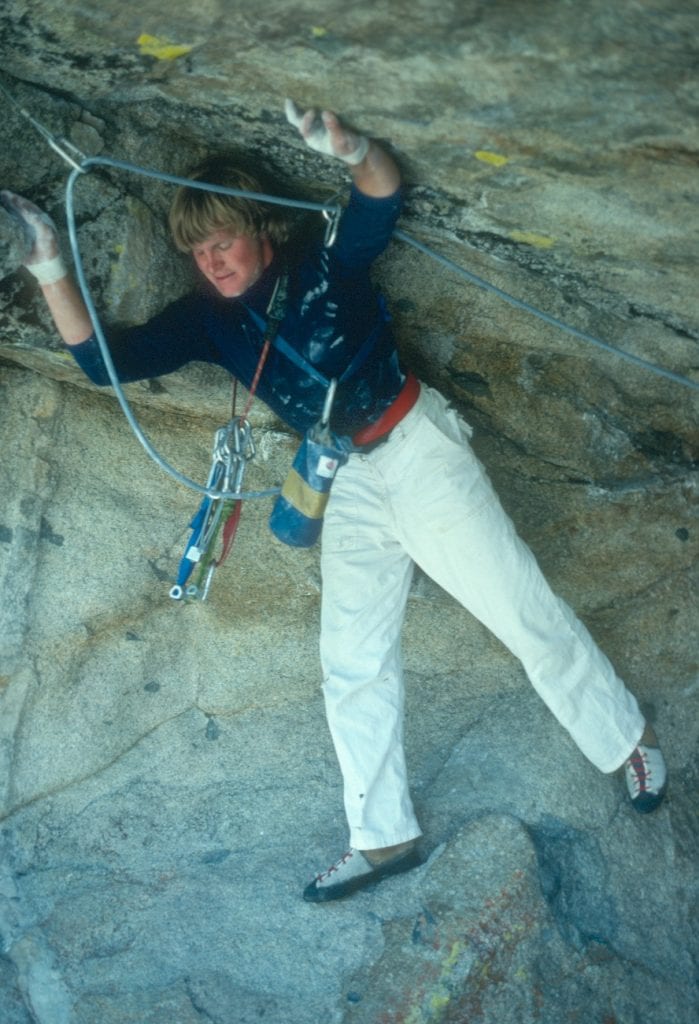
Gary Allan climbs Sky Pilot, a 5.11c, on Donner Summit’s Black Wall, photo courtesy Max Jones collection
Tahoe Basin Proves No Slouch
Bridwell was living in a trailer park in Tahoe City in the late 1970s when he told rising Tahoe climber Paul Crawford, “If you ain’t scared, you ain’t having fun.”
So recounts Crawford, who climbed and developed many of the routes in South Lake Tahoe and the surrounding region in the ’70s through the early ’80s. Crawford and Jay Smith diligently put up first ascents in climbing areas near Echo Lakes, at the Pie Shop outside of Meyers and Eagle Creek Canyon, areas renowned for clean granite and spectacular scenery.
“If I saw a bitchin’ line, I thought, ‘Cool, I got to go climb it,’” Crawford says. “If nobody had ever done it before, then they put your name in the history books.”
But Crawford says he wasn’t hunting fame. “It was for the pure sport of it,” he says.
Crawford was buddies with Dan Osman, another Tahoe legend whose climbing feats are too numerous and prodigious to recount here. The two climbers, along with the Hatchett brothers and others, developed a number of difficult lines at Cave Rock, the unmistakable rock formation on Tahoe’s East Shore with tunnels drilled through it.
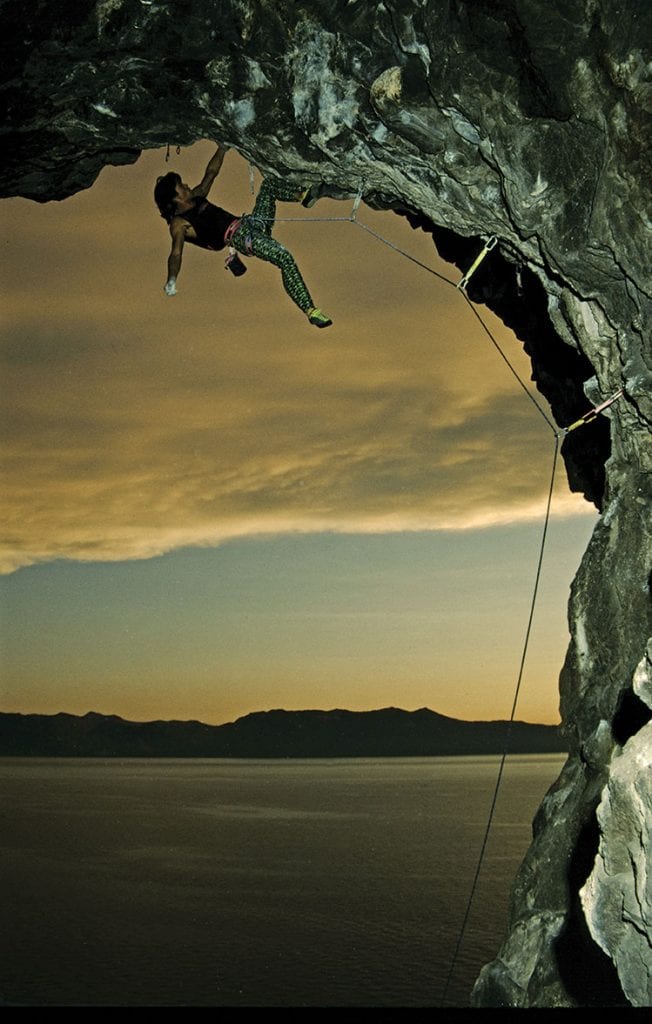
Dan Osman climbs Slayer, a 5.14 on Cave Rock on Tahoe’s East Shore, photo by Mike Hatchett
It was the 1980s and more people were beginning to accept sport climbing—which consists of drilling bolts into the rock so climbers can carry less protection and focus more on the athletic movements demanded by the climb, rather than equipment management.
“We placed [tons] of bolts on Cave Rock,” Crawford says. “I remember you could climb it in winter. One day it was snowing and we brought heaters and some reefer and had fun.”
The fun did not last, however. Osman died tragically while attempting one of his signature rope jumps in Yosemite in 1998, and the Nevada Department of Transportation shut down climbing at Cave Rock, citing concerns of the Washoe tribe, who view the rock as sacred.
For the climbing community, the decision still rankles, particularly for Crawford, who put up one of his finest first ascents, Port of Entry, on that rock. It also represents the passing of an era, as many of the partners who helped Crawford put up routes all over the South Shore in the late ’70s through the ’80s are gone.
“A lot of my buddies are in the graveyard,” Crawford says. “But I’m still around.”
Eric Perlman and Mike Hatchett provide a fuller glimpse into this era of Tahoe climbing with their Masters of Stone film series, which highlighted the talents of several climbers, including Osman, Ron Kauk, Rick Lovelace, Peter Croft and John Bachar.
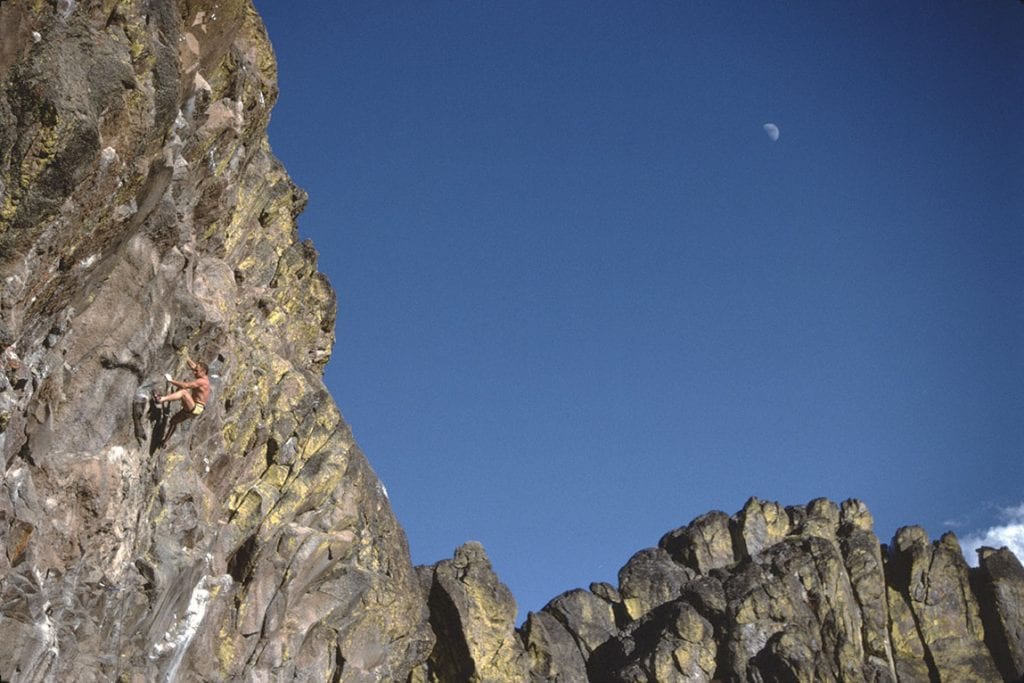 Eric Perlman climbs on Big Chief, located in the Truckee River Canyon near Squaw Valley, photo by Mike Hatchett
Eric Perlman climbs on Big Chief, located in the Truckee River Canyon near Squaw Valley, photo by Mike Hatchett
Big Chief
In the early 1990s when Dave Hatchett rappelled off anchors at the top of Big Chief, a crag in the Truckee River Canyon across Highway 89 from Squaw Valley, he felt an immediate pang of remorse.
But he got over it and kept drilling bolts in the cliff and thereby created one of the best and most unique sport-climbing areas in the Lake Tahoe area.
He’d grown up climbing with Bachar, a free soloing expert whose set of stringent climbing ethics are almost as famous as his prodigious climbing exploits. Bachar would chop bolts off of rocks and insisted the placement of bolts had to be from the ground up.
“He was the sheriff,” says Dave Hatchett.
But, Dave and his twin brother, Mike—who grew up in Southern California before moving to Incline Village in high school, and later co-founding Standard Films—came of age in a different era when sport climbing was growing in popularity.
“I grew up trad (traditional) climbing, but sport looked like fun,” says Dave Hatchett. “It was an easier, more relaxed version of climbing, and it beat being all run out and scared on trad routes.”
Not only does sport climbing cut down on equipment, it opens up routes and face climbs where “there is nowhere to get gear in,” says Carville, who has developed hundreds if not thousands of sport routes on Donner Summit, the Emeralds, Bowman Lake and other valleys west of Truckee.
The Hatchett brothers, along with Lovelace, Todd Worsfold, Jeff McKitterick, Dave Griffith, Mike Eadington, Joe Missick and others, essentially developed Big Chief in the early 1990s.
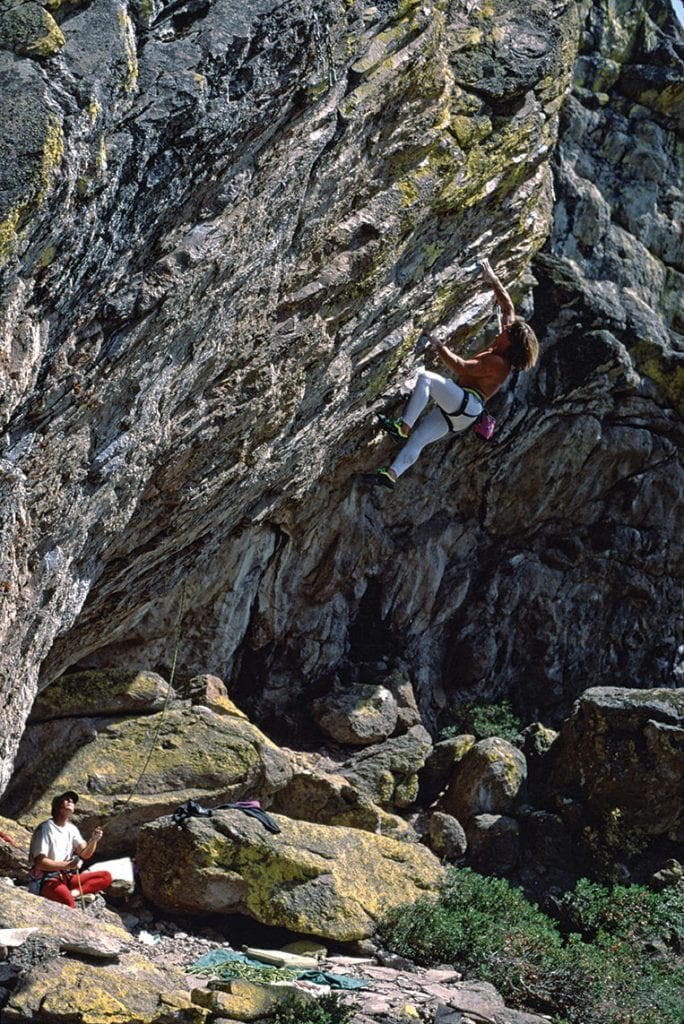
Dave Hatchett works on a first ascent of Blazing Buckets, a 5.13b, at Big Chief, photo by Mike Hatchett
Big Chief is comprised of andesite, a form of volcanic rock different from the predominantly granite lines that proliferate elsewhere in the Tahoe–Truckee area. Andesite is more prone to give way and is far slicker, making climbing it a significant challenge. Rather than climb from the ground up, as was typically demanded by old-school climbers such as Bachar, the Hatchetts established anchors at the top of the cliff, top-roped the routes and then placed bolts to protect difficult moves and the crux.
“I view placing bolts on rappel as a community service,” says Mike Hatchett, who also bolted routes with his brother at Echo Lakes. “There is an art form to it.”
Dave Hatchett agrees, saying the key to bolting the routes was to do so with a beginner or intermediate climber in mind, rather than placing bolts far apart as a display of strength and skill.
That’s not to say Big Chief lacks advanced climbing.
All Guns Blazing, a 5.13a, is one of the most difficult one-pitch climbs in the Tahoe area, and there are a few more difficult routes that begin in a cave and move out to a steep face.
The Hatchett brothers, who fittingly share the first ascent of one of the toughest climbs on the crag, are responsible for developing 90 percent of the climbing area.
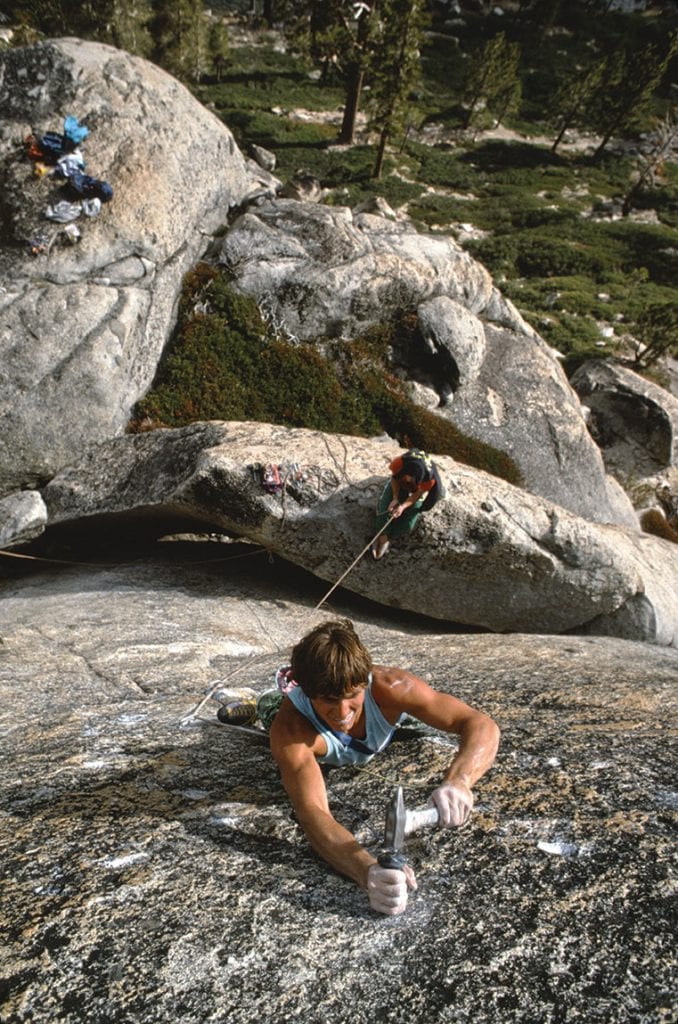
Mike Hatchett bolts a route near Echo Lakes, photo by Dave Hatchett
The Spectacular Now
What the Hatchetts started in the late ’80s and early ’90s, Carville, Josh Horniack—author of North Tahoe: A Rock Climber’s Guide—and others continue to this day.
“We must have put up around 140 bolted climbs in the past five years,” says Carville, who has developed several climbing areas off Highway 20 between Truckee and Grass Valley. “It’s a creative process envisioning a really cool line,” he says. “But it’s not important to get a first ascent; it’s more important that a cliff that should have a route on it has a line that people can climb.”
That said, harder climbing routes continue to appear in the Tahoe–Truckee area, including new sport routes in Coldstream Canyon near Truckee that rate 5.11 and up. Allan and others are working the Calavera Dome south of Kirkwood—a huge piece of granite with multi-pitch climbs—while the Hatchetts have turned their attention to bouldering and chasing arduous problems on granite scattered throughout the Northern Sierra.
There are surely other cliffs, boulders and crags throughout the greater Tahoe area that have yet to be discovered—advanced lines waiting in abeyance for tomorrow’s pioneers.
Matthew Renda is a Santa Cruz–based writer who enjoys rock climbing and once called Tahoe home.




Sandy Pavel
Posted at 21:47h, 16 MayAnd not one mention of Rick Piggot, who climbed smoother and better than all of them…